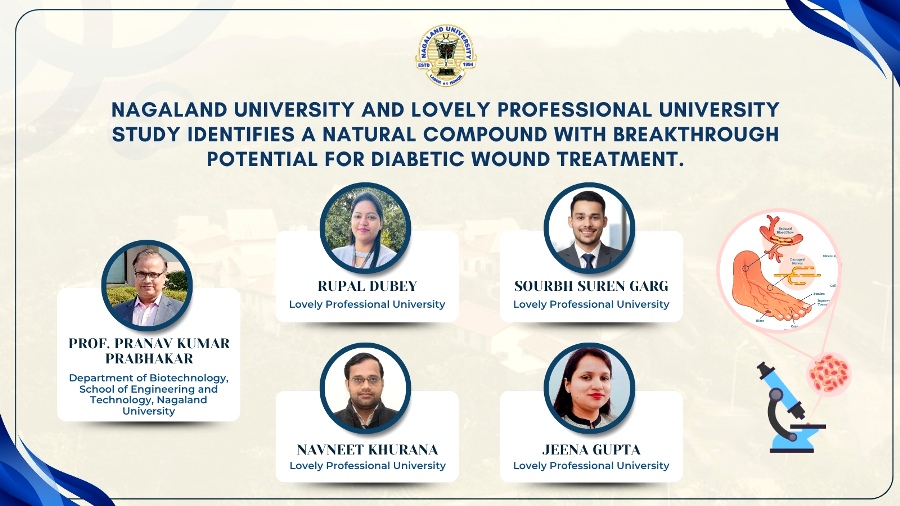SUNDAY, DECEMBER 07, 2025
- Home
- Nagaland University researchers find breakthrough for diabetic wounds
Nagaland University researchers find breakthrough for diabetic wounds
Nagaland University researchers have identified a naturally-occurring plant compound called ‘Sinapic acid.’
Share

DIMAPUR — Nagaland University (NU) researchers have identified a naturally-occurring plant compound called ‘Sinapic acid’ as a powerful therapeutic agent capable of significantly accelerating wound healing in diabetic conditions.
The discovery marks a major advancement that could result in safe, natural, and effective treatments for diabetic wound management, the university stated in a press release.
“This is the first study globally to demonstrate that Sinapic acid, when administered orally, can accelerate diabetic wound healing in preclinical models.
“The research established that the compound works by activating the SIRT1 pathway, which plays a crucial role in tissue repair, angiogenesis, and inflammation control,” it stated.
According to the university, the multidisciplinary study involved collaboration between experts from Nagaland University and Lovely Professional University (LPU), Punjab, combining expertise in biotechnology, pharmacology, biochemistry, and medical laboratory sciences.
Also read: Nagaland University research unveils health potential of tea blossoms
The research was led by Prof. Pranav Kumar Prabhakar, Department of Biotechnology, School of Engineering and Technology, Nagaland University, and included Rupal Dubey, Sourbh Suren Garg, NavneetKhurana and Jeena Gupta from Lovely Professional University. The findings have been published in Nature Scientific Reports, a peer-reviewed, open-access journal from Nature Portfolio (Springer Nature), lending strong international credibility to the research.
Highlighting the real-world impact of the research, Prof. Jagadish K Patnaik, Vice Chancellor, Nagaland University, said, “I am delighted to share that a study conducted by our researchers at Nagaland University has identified a natural compound with remarkable potential in the treatment of diabetic wounds.
This discovery not only highlights the strength of our scientific community but also reflects our commitment to addressing pressing health challenges through innovation rooted in nature.”
Professor Prabhakar elaborated that diabetes mellitus is a pressing global health challenge affecting millions worldwide. He noted that delayed wound healing, particularly in cases of diabetic foot ulcers, is a serious complication that can lead to infection and amputation. Furthermore, he pointed out that existing synthetic drugs have limited efficacy and often cause undesirable side effects.
“We set out seeking a safe, plant-based alternative — exploring how Sinapic acid, a naturally occurring antioxidant found in various edible plants, could accelerate tissue repair, reduce inflammation, and promote new blood vessel formation in diabetic wounds.
“We found that a lower dose (20 mg/kg) was more effective than a higher one (40 mg/kg), a phenomenon known as ‘Inverted Dose-Response.’ This result not only optimises dosage strategy but also has significant clinical implications for future drug development,” he added.
Dr. Gupta said, “Our findings suggest that Sinapic acid has remarkable potential to accelerate tissue repair by enhancing angiogenesis and modulating oxidative stress. Unlike topical applications or invasive treatments, oral delivery allows systemic bioavailability, enabling targeted action at the wound site.
“Building on these results, the team is also working on developing patentable formulation with Sinapic acid for easy administration, low cost, and scalability for future human trials.”
Key implications and next steps
The key implications of this discovery include reducing the risk of amputation and accelerating recovery in diabetic foot ulcers and providing an affordable, natural oral therapy, improving accessibility for patients in rural and resource-limited settings.
“This Research aligns with India’s traditional medicine and nutraceutical innovation goals, offering a safe, sustainable, and culturally compatible treatment approach,” it stated.
The research team has built robust preclinical evidence that Sinapic acid enhances wound healing, improves metabolic health, and mitigates oxidative stress in diabetic models.
The next phase will focus on translating this success into real-world therapeutics through detailed molecular pathway studies, toxicity and pharmacokinetic profiling to ensure safety, formulation development for capsules or nutraceutical tablets, and pilot clinical trials in diabetic patients to test efficacy and safety.

